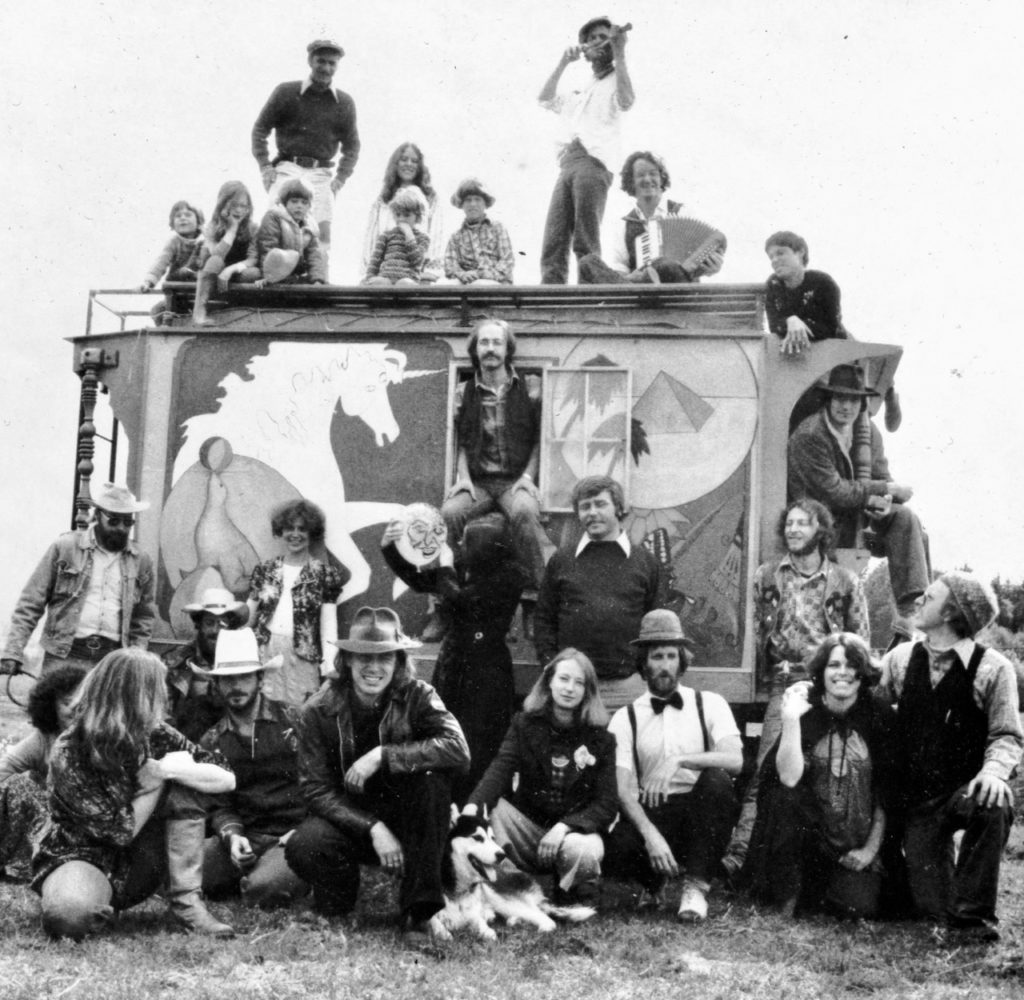
It was 2 am in the late fall of 1973, and Paul Kirby and Nans Kelder with three other adventurers were alternating riding and leading their Clydesdale horses up the old railway trail to the Coquihalla Summit, while hauling their possessions in crude pole Indigenous style travois, when suddenly they saw lights. An old trapper welcomed them into his cabin and gave them a safe place to camp for the night. They were heading to the Shuswap and their two wagons had been hauled ahead on a trailer, courtesy of the town of Hope, where they had performed their puppet theatre in exchange.
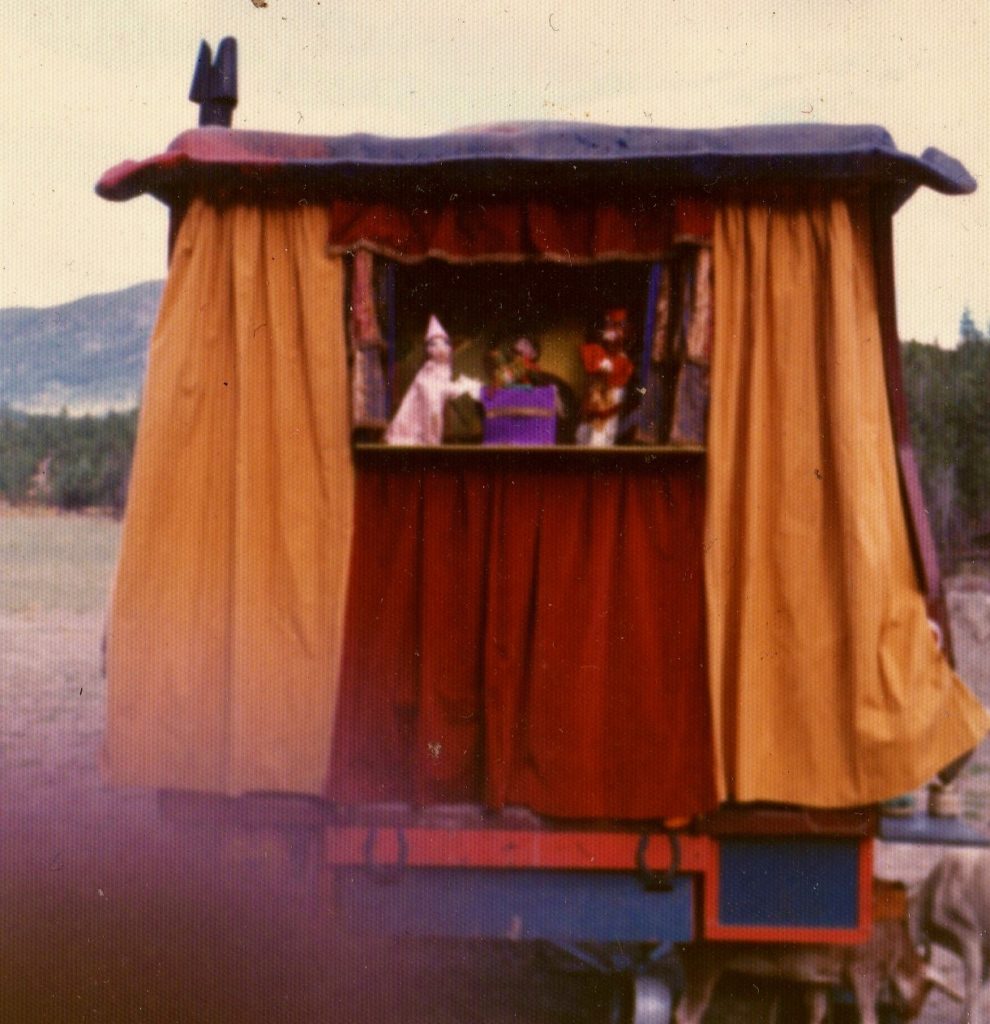
During their formative years in the sixties, Paul and Nans were living in Montreal, where they were part of a community that produced an underground newspaper and performance art pieces. They lived communally, which became the basis for the style of life they still live now on their theatre ship, the Amara Zee. In 1969 they moved to Victoria, then Sooke, where they performed puppet shows and developed the concept for a traveling troupe that uses wagons pulled by draft horses and in 1970, they formed first The Little People’s Caravan, then the Caravan Stage Company.
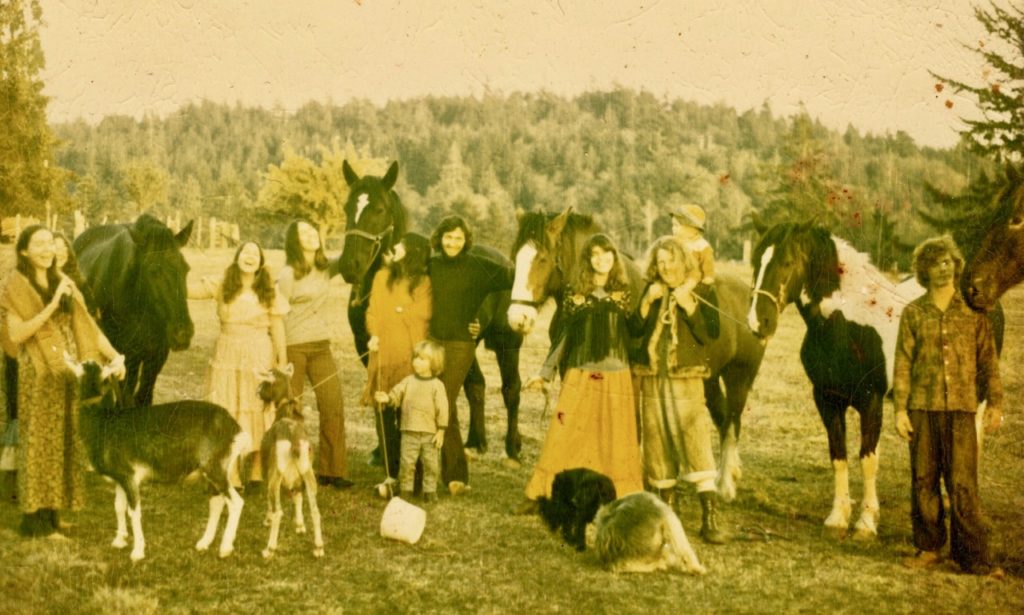
Their charisma and unique style attracted a following that included over 30 young people who joined them during a winter spent at a former mink farm in Sooke on Vancouver Island. The first wagons they built were a failure as were a few of the horses that were wild & unbroken. They persevered and two years later they toured the island with their first reliable wagon pulled by a team of bay Clydesdale mares. By 1973, they had two wagons and three young children when they began their trek that led to the interior of the province, performing along the way.
It was close to winter by the time they arrived in Merritt where they were welcomed by the Coldwater First Nation to camp on their reserve. They managed to keep warm in their wagons with their stoves heated by firewood they cut by hand with bucksaws. Chief Gordon Antoine visited them often, enjoying their camp coffee outside by a roaring fire. During this down time, Paul and Nans wrote their plan for the future, a 50-page treatise entitled “Equapolis” that was the blueprint for a cooperative and sustainable farm community run by horsepower and focused on avant-garde, traveling theatre.

A number of musicians, actors and helpers joined them during their tour in the summer of 1974 as they traveled to Salmon Arm where they spent the next winter at Yankee Flats. As the word spread about their amazing outdoor, traveling shows, their theatrical collective grew larger. In 1976, they switched from puppet shows to original theatre with their first production, “Stag King.” By the next season, the troupe included many who became long-term Caravaners, including Nick Hutchinson, Molly March, Peter Hall, Michelle Carriere, Catherine Hahn, Sue Kyle, Alan Bates, Peter Anderson, Doug Saba, and Paul White. (To name but a few, as there were many more actors, musicians and production people involved in the early years.)
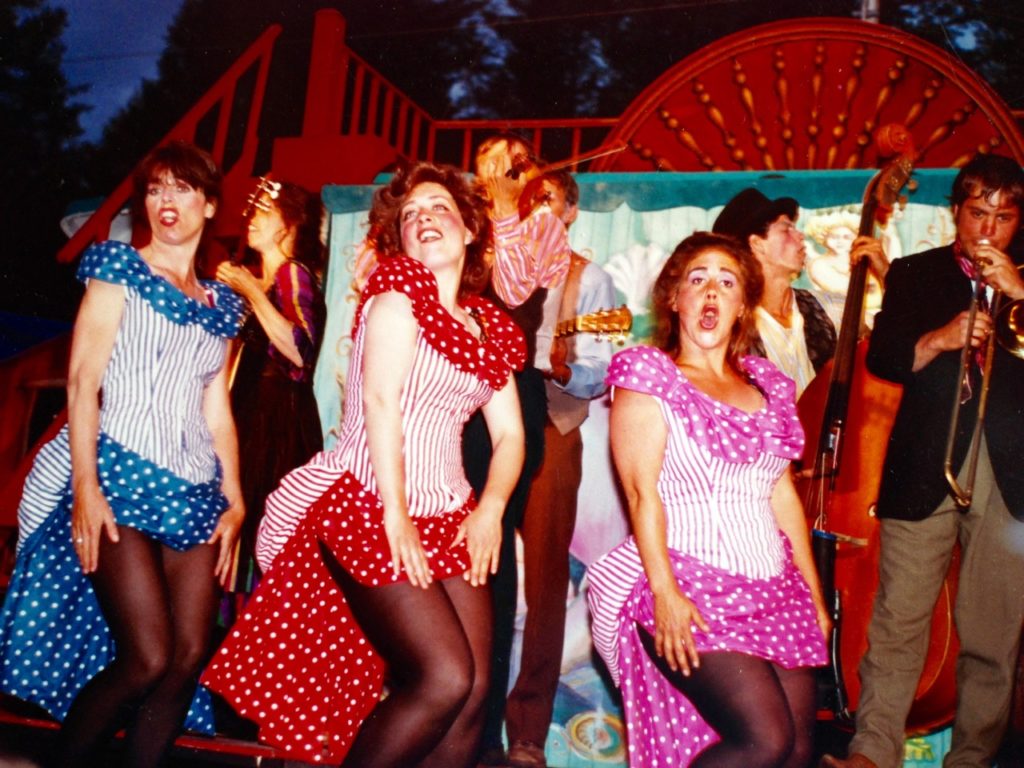
In 1977, they produced the show that truly helped to make them famous, the historical musical “Hand’s Up”, which was the story of the famed Kamloops train robber, Bill Miner. The following year they performed the much loved “Coyotes,” which was re-staged by the Caravan Farm Theatre in 2019. This was also the year they finally found an 80-acre farm to own, which they were able to purchase using Paul’s inheritance and funding from Catherine Hahn for the down payment. True to their ideals, the farm’s deed was registered under their newly formed Bill Miner Society for Cultural Advancement, so that everyone who was part of the company was also a co-owner of the farm located in the hills above Silver Creek, just inside the boundary of the Shuswap watershed.
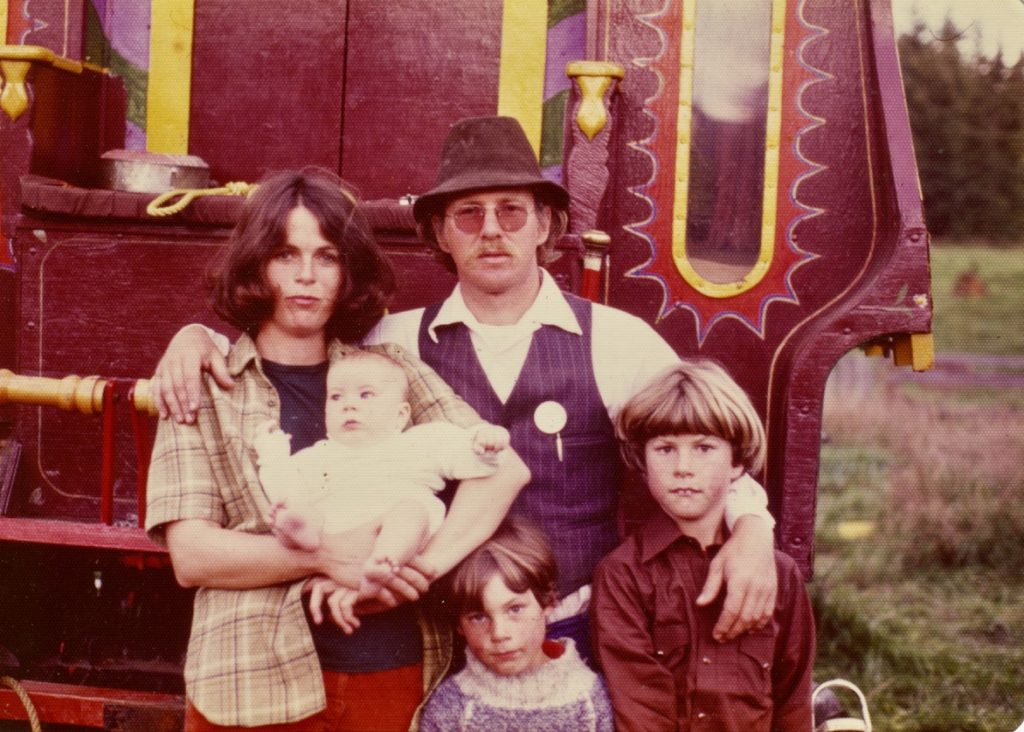
Once they returned home from the 1978 tour of Alberta, their first tasks were to build the structures they needed for both homes and to produce their shows. Unfortunately, during the tour, the existing barn burned down along with a wide variety of farm equipment they had collected over the years and a crop of hay. Within in a year, with help from many locals who donated their labour and funds, they built a new barn and scene shop, a cook shack and a home for Nick and Molly. As well as another log cabin built by Horse-Logger poet Lorne Dufour, who traded it for a horse, was moved to the farm.

Despite receiving grants and donations, there was most always a budget shortfall. Paul and Nans met frequently with a philanthropist, Robert Cabot, who was funding a number of intentional communities and helping protect ecological values in private land. Funding was provided through the Turtle Island Earth Stewards that ensured that the farm’s Coyote Rock bluff was protected in perpetuity. Despite many long meetings at the farm, there remained an impasse over the proposal to become a land trust. Finally, in 1984, Paul and Nans left the farm with the wagons, as they preferred the life as nomadic performers rather than having to negotiate the compounding problems of running a property. And then, the new era of the Caravan Farm Theatre began.

POSTSCRIPT
The text above barely scratches the surface of the story, as so much more could be written about the early days of the Caravan. They were young, idealistic artists who poured their hearts and souls into the shows that thrilled so many people who came out in droves to enjoy superb live theatre. When they took a show on the road, they took five wagons, pulled by nine Clydesdales, seven riding horses, two goats, numerous dogs, and 24 performers and support staff, some who brought their children too. Averaging 19 kilometres a day, the troupe members had a variety of jobs to do, from teamster, to cleaning, to setting-up and taking down the sets, to singing and dancing. The tours were both hard work and days filled with laughter or as one caravaner described it, “a travelling massage parlour.”
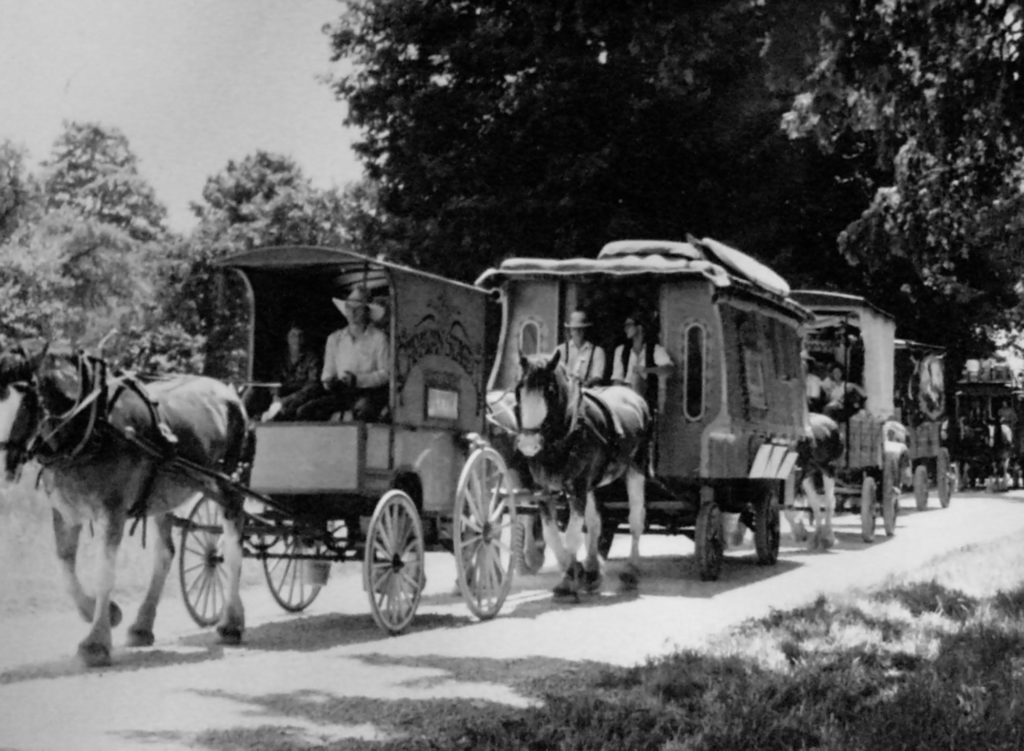
In 1978, filmmaker Dorothy Henaut spent several weeks with the Caravan when they were touring Alberta with Hands Up! and also filmed during the final show at the Armstrong Fair. The result was a 27-minute documentary called Horse Drawn Magic that hit at the 1979 Toronto Film Festival, as well as throughout Europe. It can now be streamed for free on the National Film Board website here: Horse Drawn Magic.
When Paul and Nans were camped at the Cold Water Reserve near Merritt during the winter of 1973/74, they envisioned utopia that would be a “back to the horse” community. Their future blueprint, Equatopia, included 10 principles including purchasing a farm, creating a community based on culture, breeding work horses, employing sustainable forestry and agricultural practices and advancing technology that utilized horse power. Years later, when the dream became reality, the revenue from show ticket sales rarely covered all their costs, so Paul often had to find sponsors and apply for grants, as well as look for donations.
While summers were extraordinarily busy especially during the rehearsal period, winters were very quiet. There were often just eight people plus children living in four buildings, the old red farm house, Nick and Molly’s house, the log cabin from Lorne Dufour and the original tiny, log gate house, while the cook shack sometimes doubled as a living space too.
Paul White was a key part of the production crew, who also helped build the wagon shed and cook shack as a volunteer. He also lived at the farm for a number of years in a motorhome with his family. In addition to his role as a “techie,” he also spent a number of years preparing a land use plan for the property that was never fully incorporated and he stayed at the farm for about three years after Paul and Nans left.
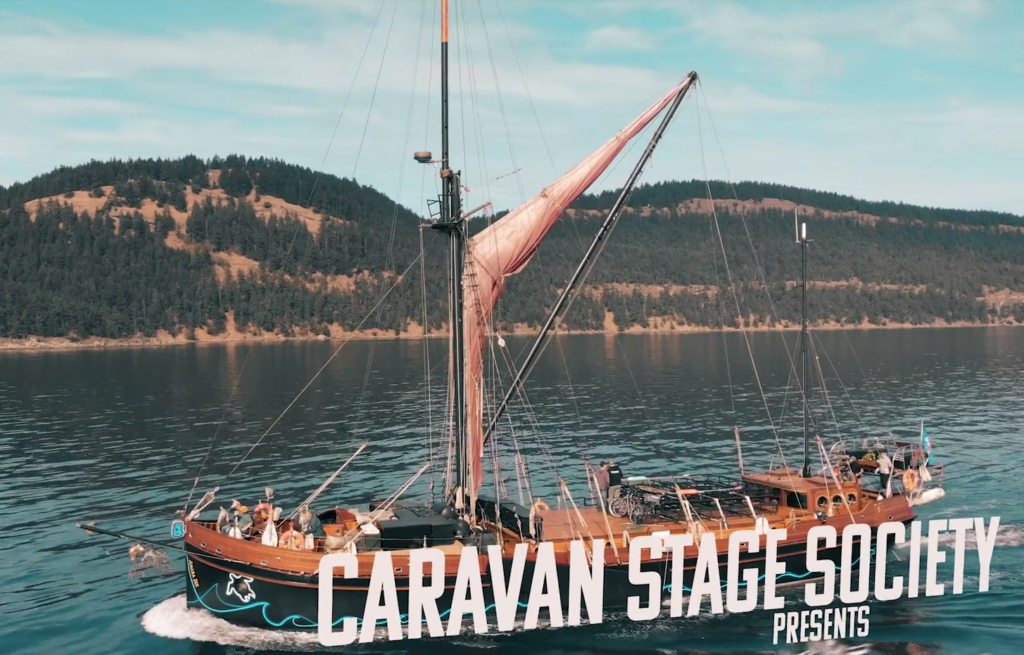
In 1984 when Paul and Nans left, they continued touring with the wagons for three years in Washington, Oregon and California where they performed Hands Up! and Coyotes and returned to B.C. in 1986 to present a new show, Manifold Destiny, at Expo 86. In the following years, they toured with more new shows in the Gulf Islands, eastern U.S., Ontario, Quebec and Florida. They finally parked the wagons in 1993 to spend the following four years constructing the Caravan theatre ship, Amara Zee. From 1996 they performed original “operatic spectacles” throughout eastern Canada and the U.S. ending up in New Orleans in 2004. The following eight years were spent touring on rivers and canals throughout Europe, after the Amara Zee was shipped across the Atlantic on a freighter. Returning to the U.S. in 2013, they then went on another U.S. and Canada tour. The ship was brought back to B.C. in 2018 for a total restoration at a dry dock in Victoria, with financial support from the B.C. Government. A new show, Virtual Roads is ready, but will now have to wait until 2022 due to the pandemic. Learn more about the Caravan Stage Company at their website or by watching this video.







